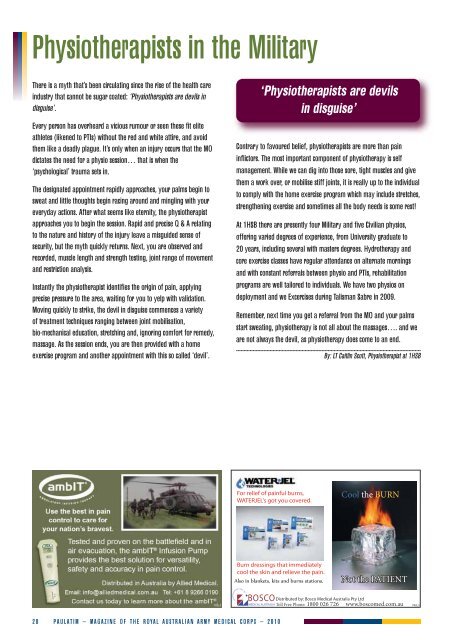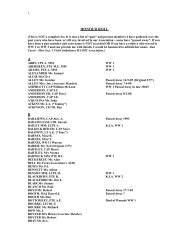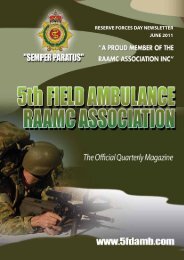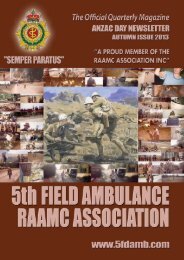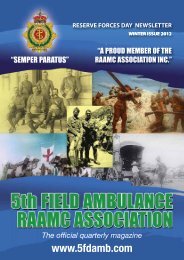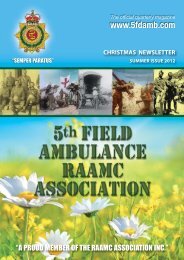2010 Paulatim Magazine - RAAMC Association
2010 Paulatim Magazine - RAAMC Association
2010 Paulatim Magazine - RAAMC Association
You also want an ePaper? Increase the reach of your titles
YUMPU automatically turns print PDFs into web optimized ePapers that Google loves.
Physiotherapists in the Military<br />
There is a myth that’s been circulating since the rise of the health care<br />
industry that cannot be sugar coated: ‘Physiotherapists are devils in<br />
disguise’.<br />
Every person has overheard a vicious rumour or seen these fit elite<br />
athletes (likened to PTIs) without the red and white attire, and avoid<br />
them like a deadly plague. It’s only when an injury occurs that the MO<br />
dictates the need for a physio session… that is when the<br />
‘psychological’ trauma sets in.<br />
The designated appointment rapidly approaches, your palms begin to<br />
sweat and little thoughts begin racing around and mingling with your<br />
everyday actions. After what seems like eternity, the physiotherapist<br />
approaches you to begin the session. Rapid and precise Q & A relating<br />
to the nature and history of the injury leave a misguided sense of<br />
security, but the myth quickly returns. Next, you are observed and<br />
recorded, muscle length and strength testing, joint range of movement<br />
and restriction analysis.<br />
Instantly the physiotherapist identifies the origin of pain, applying<br />
precise pressure to the area, waiting for you to yelp with validation.<br />
Moving quickly to strike, the devil in disguise commences a variety<br />
of treatment techniques ranging between joint mobilisation,<br />
bio-mechanical education, stretching and, ignoring comfort for remedy,<br />
massage. As the session ends, you are then provided with a home<br />
exercise program and another appointment with this so called ‘devil’.<br />
‘Physiotherapists are devils<br />
in disguise’<br />
Contrary to favoured belief, physiotherapists are more than pain<br />
inflictors. The most important component of physiotherapy is self<br />
management. While we can dig into those sore, tight muscles and give<br />
them a work over, or mobilise stiff joints, it is really up to the individual<br />
to comply with the home exercise program which may include stretches,<br />
strengthening exercise and sometimes all the body needs is some rest!<br />
At 1HSB there are presently four Military and five Civilian physios,<br />
offering varied degrees of experience, from University graduate to<br />
20 years, including several with masters degrees. Hydrotherapy and<br />
core exercise classes have regular attendance on alternate mornings<br />
and with constant referrals between physio and PTIs, rehabilitation<br />
programs are well tailored to individuals. We have two physios on<br />
deployment and we Excercises during Talisman Sabre in 2009.<br />
Remember, next time you get a referral from the MO and your palms<br />
start sweating, physiotherapy is not all about the massages…. and we<br />
are not always the devil, as physiotherapy does come to an end.<br />
By: LT Caitlin Scott, Physiotherapist at 1HSB<br />
For relief of painful burns,<br />
WATERJEL’s got you covered.<br />
Cool the BURN<br />
Burn dressings that immediately<br />
cool the skin and relieve the pain.<br />
<br />
Not the PATIENT<br />
PAUL-3<br />
Distributed by: Bosco Medical Australia Pty Ltd<br />
Toll Free Phone: 1800 026 726 www.boscomed.com.au<br />
PAUL-3<br />
2 0 P A U L AT I M – M A GAZINE O F T HE R OYA L A U S T R A L I A N A R M Y M E DICAL C O R P S – 2 0 1 0


